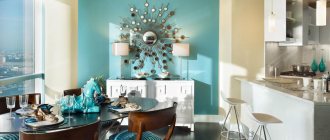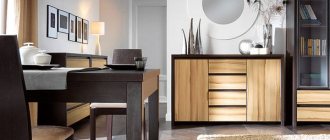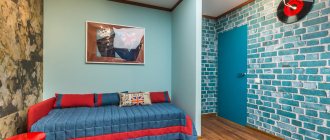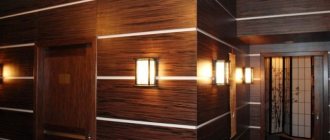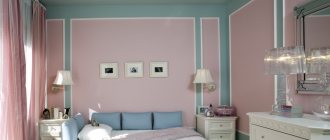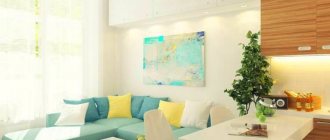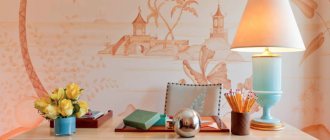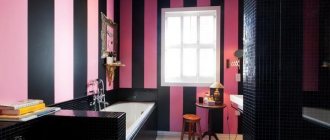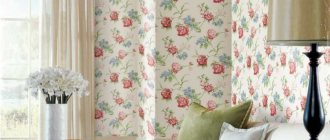When choosing a method for decorating walls, many people prefer traditional painting. A painted wall will suit and fit well into both classic and modern interiors such as minimalism. Coloring is a powerful design tool that allows you to create unique effects. An interesting approach is to paint the walls in two colors in the apartment. With this design you can add the powerful energy of pop art to the room or bring a harmonious backdrop to classic interiors.
Choice of colors: combination of different shades when painting
Depending on the size of the room and its architectural features, you can play with the stylistic direction using color composition: place accents on bright moments, hide unwanted defects.
For small rooms
Color will make a narrow room cozier. Pure tones expand the space, and a palette of grassy, blue, and purple solutions visually distances the space, making the room larger. Using this technique, an end or side partition will create the width of a narrow room, and will make a small one appear larger.
The hallway in most cases is of modest size. The optimal tone for it would be light (beige, ivory, etc.) with brighter accents.
Brightly painting the radiator and window sill expands the space. Paint one of the walls a different color. Use shades to bring the space closer together.
For large spaces
Painting the walls is the beginning of the solution. The dominant color creates harmony, and contrasting options are used as accents to interior elements (fireplace, mirrors, etc.). Adjacent rooms with shades of bluish, gray-green and bluish-green will add harmony and cohesion.
The uniform color of the rooms adjacent to the hall creates the impression of integrity of the interior parts. Among the “cold” colors, it is recommended to choose blue, which creates sophistication and nobility.
The dark tone is given to the lower room, the middle zone - lighter, and the upper - the lightest. Color effects will make a space appear larger or smaller, and contrasting opposing walls will make a space appear larger.
Oversaturation is eliminated:
- Different textures when painting a room with one color.
- Rooms with different color schemes are united by a single floor, connecting the volumes of the rooms.
For kitchens and baths
Painting the kitchen orange improves digestion, improves mood, does not tire your eyesight, and adds vigor.
The kitchen on the south side is painted in cool colors, on the north side - in warmer colors: orange, golden, red and pink colors are also recommended.
It is better to paint a small kitchen with soft, pastel colors to expand the space.
When painting a bathroom, moisture-resistant painting materials are used. Water-based and acrylic paints are better suited: acrylic dries quickly, and latex paint prevents the appearance of fungi and mold, and prevents the formation of condensation and smudges.
The ceiling of a small bathroom is painted a light color. This option visually increases the space of the room without reducing its height.
For rooms
For rest rooms and bedrooms, it is better to choose calm shades, since the red color of the dining room stimulates the appetite, and shades of yellow are suitable for the office.
For a classic combination, choose black, white and gray colors.
Blue, pink and yellow shades are best suited for children's rooms.
Blue and gray shades are suitable for office spaces.
For bright finishes, choose a contrasting option. Finishing the background for decorative elements requires the use of paints that are similar in spectrum.
Cool shades visually expand the room, while warm shades create coziness.
Kitchen decoration
Painted walls are the best option for the kitchen. Ceramic tiles are not affordable for everyone, and wallpaper is short-lived and does not tolerate constant moisture and elevated temperatures.
- For this room it is best to use the ombre technique. The vertical transition of colors occurs from dark to light tones, from floor to ceiling. This method of painting is suitable for kitchens of any size and allows you to visually raise the ceiling.
- If the area allows, then you can make a horizontal degradation. A darker shade is used in the depths of the room. The area near the window is painted in light colors. This allows you to enhance natural lighting.
- The gradient can have clear transition boundaries between light and dark areas; it is used only for vertical coloring. But smooth transitions and leveled outlines look more original. This design creates a feeling of comfort and peace.
- To create a complete picture, you can use ceramic tiles matched to the ombre tone.
- Vintage rhombuses on the wall are suitable for a retro-style kitchen. This is one of the most labor-intensive types of design, but the result is interesting and unusual, warm and somewhat naive. The painted wall looks like a knitted vest. After painting is completed, lines or dotted lines can be applied to the borders of the diamonds. This will help achieve maximum similarity with the knitting pattern.
- A kitchen in purple tones looks original, non-standard and new. But an excess of this color makes the kitchen uncomfortable. As a companion color, you can alternate light shades of gray and white. The salad-purple combination looks original.
When thinking through the design of an apartment, it is necessary to take into account the preferences of all household members. Color design should not irritate the psyche or tire the eyes. Comfort and tranquility are the basic rules of a cozy home.
Design of combined wall painting: several colors for decoration
Combined coloring visually divides the space into two parts: from the floor in one color, and above - in another. Sometimes the border is drawn close to the surface of the ceiling. It all depends on the size of the room and the stylistic decision.
Horizontal painting
The border between two colors is decorated with polyurethane molding, a wooden strip, a stone border or a pebble mosaic along the joint on liquid nails with a neat border.
The horizontal line imitates the bottom panel of the wall. Horizontal splitting and moving border effects are more suitable for children's rooms.
Ideas for color inserts
This option is effective for simulating decorative panels. The wall is painted in the base color. Markings are carefully applied to the dry walls and the contours of the colored inserts are covered with masking tape. After which they are painted with a predominantly dark shade in comparison with the main one. The tape is removed and the frame is created.
Colorful accent on one wall
The following conditions help to accentuate the wall:
- there is only one accent wall, sometimes two;
- it is possible to highlight a portion of the wall or accentuate architectural elements: arches, niches;
- the emphasis is made in contrast or with a smooth tonality;
- using warm and cold shades visually adjusts the distance to the wall of the living room or dining area of the kitchen.
Gradient coloring in two colors
The painting technology is similar to the previous option (accentuated type painting). The difference is in the gradient shades of the same color.
The intensity of the color increases from top to bottom; the dark shade is placed closer to the ceiling. Lightening in this case is closer to the floor.
It is possible to use gradient coloring in a horizontal position from left to right or vice versa.
Ornaments and shapes
Color compositions of ornaments and patterns attract attention, especially if you approach this issue creatively: patterns in the national color in the kitchen or intricate figures in the children's room will certainly decorate the entire apartment. Both individual ornaments and sets of one style and color are available for sale.
Pros of painting walls in two colors
Two-color wall painting has the following advantages:
- ease of use - painting walls in two colors practically does not require any special skills or tools, so anyone can cope with this task;
- versatility - this finishing option is suitable for any residential and non-residential premises;
- the ability to change the shade - if after some time you get tired of the color of the walls, you can easily change it by repainting part of the wall or one of them;
- ease of selection of furniture and other interior items;
- original appearance - with just two colors you can come up with countless finishing options to suit every taste.
How to calculate the ideal paint combination for a wall
To calculate paint consumption, measurements are taken of the surface to be painted and the surface features are taken into account. On average, paint consumption is 1 liter per 8 square meters. meters. Window and door openings are taken into account, the areas of which are subtracted, the areas of window sills and baseboards are added to the areas of the walls.
Before painting, the walls are leveled, prepared by sealing defects and treating with a primer. Painting is carried out from corners, door and window openings, baseboards with final treatment with a spray gun. Paint consumption is determined taking into account its specific consumption indicated on the packaging.
When making adjustments, the characteristics of the surface being painted are taken into account:
- color;
- texture;
- number of layers.
The basis is a plastered primer.
On wooden plastered surfaces, consumption increases by 6-10%, on metal - 13-15%, on unpainted plasterboard - 40%, on embossed wallpaper - by 70%.
The tool for applying paint is taken into account: roller, brush, spray gun. The roller and spray gun reduce consumption.
Preparing the walls
To paint walls in two colors you will need a regular roller, brush or spray gun, masking tape and paint (acrylic or latex water-based). Today there is a huge selection of different shades on the market, or if you wish, you can create your own color. Before you begin, you must carefully prepare the surface to be painted: get rid of old finishes, dust, dirt, cracks and irregularities. Then the wall is coated with a primer, preferably acrylic.
Advice. It will simplify the process of applying paint, protect the surface from fungi and mold during operation, and also make the coating more durable.
You will have to prime several times: first after cleaning the walls, and then after applying putty and immediately before painting. In some cases, wall preparation may not be necessary, for example, in interiors where slight negligence of decor, any unevenness and defects are welcome.
Advice from professionals
3 ways to combine colors.
- Colors of a close or related type or two pastel cold types.
- "Gradient". Tones of the same color with different saturation.
- Various colors.
The boundaries between the colors are drawn.
Wall painting options:
- dividing walls horizontally;
- the use of strips when decorating walls;
- gradient coloring;
- panel inserts;
- relief selection;
- creating correct geometric shapes;
- irregular lines with complex shapes;
- the effect of color on the dimensions of a room.
Painting walls in two colors is a popular type of decoration that creates a minimalist style. Combined coloring provides peace of mind and creates original interior solutions.
What to consider when combining coloring
The basic rule is a reasonable combination of colors. There are 3 combination options:
- related shades - classic black and white, neutral, pastel cold tones,
- degrade - a transition within one color from dark to light tones,
- a combination of different colors taking into account saturation and temperature.
Combining colors requires care. You will need high-quality masking tape that will protect the surface and come off easily. To decorate less-than-ideal borders, you can use polyurethane molding, paper and stone borders, mosaics and decorative slats. All markings must be made only after the paint has completely dried.
The catalogs present a huge number of shades. But if none of them is suitable for decoration and design, you can create any shade yourself. You just need to do this with a reserve, since it can be difficult to re-mix the desired color.
How to fix sagging on an already painted surface?
If stripes do appear on the wall, it will take a lot of time and effort to remove them. The main thing is to work very carefully so as not to spoil the edges of the applied “striped” pattern. Correcting defects will be more difficult.
The coating must be thoroughly dried . If the imperfections are very obvious, then it is better to reapply a layer of finishing putty and start painting again. Most often, such phenomena will occur in hot, dry rooms, so when painting you need to take care of a suitable microclimate: install a humidifier and reduce the temperature to 16-22 °C.
It is not worthwhile to equalize the temperature regime by ventilation, since drafts lead to uneven drying of the coating and the appearance of stains on painted surfaces.
Each layer must be applied with a “live” roller, which retains a little of the composition in the structure of the fur coat. If you squeeze it out to the maximum, it is more difficult to achieve uniform coverage. Adding no more than 10% water or solvent to the coloring material will even out the consistency. It is necessary to re-coat or apply stripes of a different color only on the dried layer.
Due to the “wet edge” technique, when each subsequent stroke is applied to the previous wet stroke, maintaining the same structure and consistency of the coating, uniform color of the finish is achieved.
Fashionable “striped” walls are easy to make, adhering to basic techniques for applying compositions and rules for working with paints and varnishes. Such interior decoration will change its geometry and make the design individual. But you need to remember a sense of proportion and use up to 3 primary colors , otherwise the room will turn into a circus arena or create the impression of eternal chaos.
Think outside the box
Do not think that applying stripes in two directions is the only option. For example, you can arrange the stripes diagonally. In this case, the effect of expanding the space in width will remain, but the ceilings will not seem lower. Another option is to make the stripes broken or make them intersect. The scope for creativity is incredible, and the painting process itself does not change - it all depends on how exactly you create the markings and glue the masking tape.
An interesting idea would be to paint not the entire wall with stripes, but, for example, only the sleeping area. This way you can delimit the space. Well, if you want to make a truly unusual room design, then continue the stripes from the walls to the ceiling.
